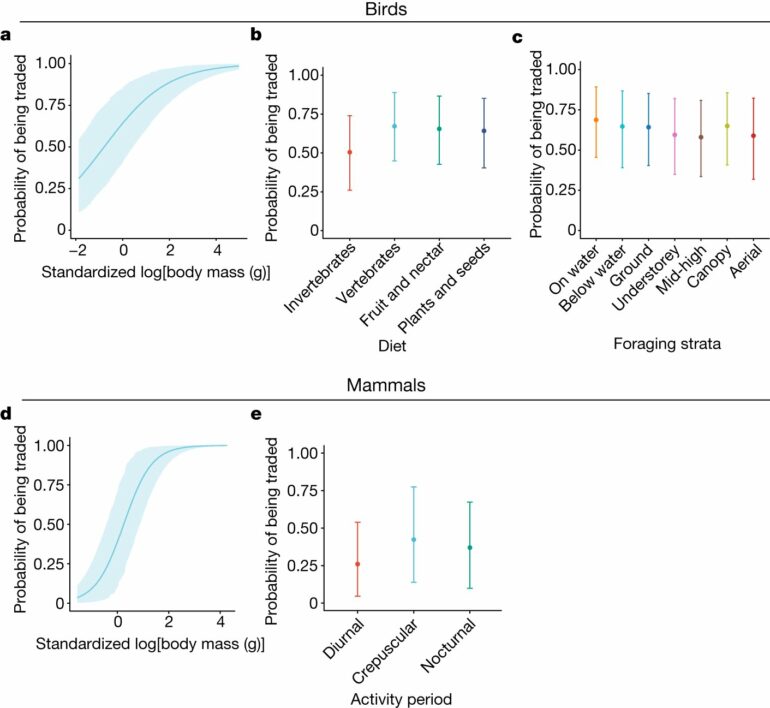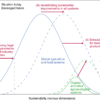Some of the world’s most distinct and ancient animal species, which play crucial roles in our planet’s ecosystems, are exploited for the wildlife trade across large parts of the world, according to new research from the University of Sheffield.
The study, led by researchers from the University’s School of Biosciences, has found that in large areas of the world, a wide range of functionally and evolutionarily distinct species are targeted for the wildlife trade, which has the potential to cause major losses of evolutionary history and alter key ecological processes.
Published in Nature, the research has found that hotspots of traded birds and mammals are largely in the tropics. These are some of the most biodiverse areas on Earth, but the trade of unique birds and mammals key to the functioning of these ecosystems has the potential to alter vital ecological processes, with knock-on effects for biodiversity and human communities dependent upon them.
Researchers in the study are now calling for conservation resources—both financial and political—to be directed towards the tropics and other major hotspots in the global wildlife trade.
Professor David Edwards, from the University of Sheffield’s School of Biosciences and senior author of the study, said, “Thousands of species are traded globally and many of these are done so unsustainably. We urgently need to focus conservation resources towards trade hotspots, such as those in the tropics, to prevent extinctions.”
“At present, we’re in grave danger of losing some of the world’s most evolutionarily and functionally distinct animals, and this could have major consequences for our planet’s ecosystems.”
The researchers brought together previous research on birds and mammals in trade with global evolutionary and trait datasets to map different important aspects of diversity present in trade. This includes functional diversity, which captures the breadth of different traits and roles species play in ecosystems (rather than just the number of species).
They also explored phylogenetic diversity, which describes the evolutionary history present in a wildlife community—for example, a community with species from a diverse range of groups or from ancient lineages (such as pangolins and elephants) would be more phylogenetically diverse than a community of closely related species. Both are important measures of biodiversity and ecosystem health, and communities with greater functional and phylogenetic diversity will be more resilient to disturbance.
By overlaying the range maps of birds and mammals in trade, they found that an overrepresentation of these metrics are in use across much of the world, particularly so in tropical regions. Areas of South-East Asia and sub-Saharan Africa have the highest levels of traded phylogenetic diversity, while parts of South America also emerge as epicenters of traded functional diversity.
“This high level of use suggests that if trade here is unsustainable, it risks substantially altering the evolutionary history present within these communities and the functioning of these ecosystems,” says Liam Hughes, lead author of the study.
Even after accounting for the greater number of species traded in the hyperdiverse tropics, the study still finds much of the tropics are global epicenters of traded functional and phylogenetic diversity.
Accounting for the number of species present also highlights new hotspots for mammals in North America (where high amounts of evolutionary history are traded for the relatively low species richness of trade) and Europe (where a relatively low number of species across a whole range functional roles are in trade), suggesting trade could also impact ecological processes in these regions.
The team also found that larger species tend to be disproportionately represented in trade, suggesting that exploitation may particularly diminish the unique role they play in ecosystems. For example, the evolutionary distinct African Forest Elephant plays a vital role in ecosystems, creating openings in the Congo forests and dispersing the seeds of a wide-range of tree species.
Yet poaching for their ivory has led to widespread declines in recent decades, with long-term ramifications for forest health and carbon stores. Similarly, large birds such as hornbills are critical to dispersing large seeds over long distances, but trade of species such as Helmeted Hornbill—the unique casques (or ‘red ivory’) of which are highly-sought after—has contributed to this once abundant species being considered Critically Endangered.
The authors highlight that further work must address our current poor understanding of trade sustainability for the thousands of species in trade and call for an increased focus on species roles in ecosystems in sustainability assessments. “Species that are evolutionary distinct contribute more to the functioning of our ecosystems, so it’s essential for the health of ecosystems that we protect these species and ensure that they are not being exploited unsustainably,” says Liam Hughes (lead author).
“When we remove or deplete certain species for trade, we risk changing the myriad of interconnected services that the ecosystem provides. This is similar to removing bricks from a building—if we remove too many we risk the whole building crumbling down. But at present we understand frighteningly little of the scale of the issue or its wider implications for ecosystems,” says Dr. Oscar Morton from the University of Sheffield’s School of Biosciences and a co-author of the study.
The study is published in Nature.
More information:
David Edwards, Global hotspots of traded phylogenetic and functional diversity, Nature (2023). DOI: 10.1038/s41586-023-06371-3. www.nature.com/articles/s41586-023-06371-3
Provided by
University of Sheffield
Citation:
Global wildlife trade risks altering evolutionary history and ecosystem function, study suggests (2023, July 26)



